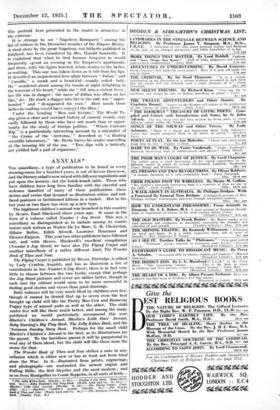ANNUALS *
THE miscellany, a type of publication to be found in every drawing-room for a hundred years, is out of favour there now, and the literary salad is now mixed with different ingredients and put upon the nursery, not the knick-knack table. Those who have children have long been familiar with the cheerful and
welcome inanities of many of these publications—those stories and verses that demand as illustration robins and red- faced postmen or beribboned kittens in a basket. But in the last year or two there has risen up a new type.
The highbrow children's annual was launched in this country by Messrs. Basil Blackwell three years ago. It came in the
form of a volume called Number 1 Joy Street. This was a
miscellany so distinguished as to include among its contri- butors such writers as Walter De La Mare, G. K. Chesterton, Hilaire Belloc, Edith Sitwell, Laurence Housman and Eleanor Farjeon. This year two other publishers have followed suit, and with Messrs. Blackwell's excellent compilation
(Number 3 Joy Street) we have also The Flying Carpet and another miscellany of a rather different kind, The Wonder Book of Then and Now.
The Flying Carpel is published by Messrs. Partridge, is edited by Lady Cynthia Asquith, and has as illustrious a list of contributors as has Number 3 Joy Street ; there is in fact very little to choose between the two books, except that perhaps the Joy Street pictures and cover are rather better, though in each case the editors would seem to be more successful in finding good stories and verses than good drawings.
Both volumes will be very much liked by children over five, though it cannot be denied that up to seven even the best brought up child will like the Pretty Moo Cow and Bouncing Puppy type of annual quite as well as the other. The child under five will like them much better, and among the many published we would particularly recommend this year Mackie's Children's Annual, Black-it's Little Ones' Annual,
Baby Bunting's Big Play Book, The Jolly Kitten Book, and the 'Normous Sunday Story Book. Perhaps for the small child Blackie's Children's Annual is the best, as its illustrations are the gayest. To the fastidious parent it will be purgatorial to read any of them aloud, but the child will like them none the worse for that.
The Wander Book of Then and Now strikes a note in mis- cellanies which is either new or has at least not been tried since the War. In it—illustrated from prints, engravings, and photographs—are contrasted the newest engine and Puffing Billie, the first bicycles and the most modern ; and so on from Montgolfier to Count Zeppelin, in all sorts of fields-- • The Jolly Hilten Book. (Mackie. ls.0d.)--Number 3 Jog Street. (Basil • 6s.)--Baby Bunting's Big Play-Book (Ward, Lock and Co. fa. 6d.)--- Mackie's Lit* Ones' Annual. (Mackie. 3s. 6d.)—The Plying Carpet. (Part- ridge. Cs.)—Blarkie's Children's Annual. (Mackie. 5.)—The Wader Book of Then and Now. (Ward, Lock and Co. 6s.).—The 'Normous Sunday Story Book. (Stanley Paul. 5s.) cricket, golf, the ifieaire, fire_ engines,.and so forth. The boOk is entertaining and should prove a most valuable companion to the history hook. But in hopeg of a new and enlarged edition next year, may we offer some criticisms? The matter is suitable to children of seven or eight, but the allusive poly- syllabic leading article style isunsuitable, nay incomprehensible. Again if there could be some very simple .system of cross' reference the -book would -'be -More -delightfill. The child . would lik to know which_- bicycle was contemporary with -Which aircraft for instance, and which stage coach with which ship. Als6 we should like to see much more about food,. Clothes and children's toys, These are everyday factors Which greatly help the child reader to transport himself to another age- and prevent the past from returning to that vague state in "which the infant conform& Canute, Queen Elizabeth and its great grandfather. It would be delightful, too, to have a series of companion volumes dealing in the Same sort of way with distant and romantic countries.























































 Previous page
Previous page